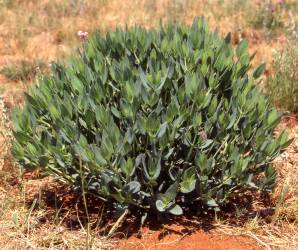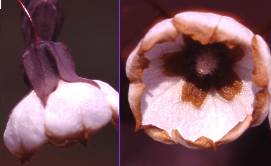Trichodesma physaloides
Trichodesma physaloides (Fenzl) A.DC.
Family: Boraginaceae
Common names: Chocolate Bells
Introduction
Drooping flowers with large, brownish purple calyces and white corollas characterise this plant which is conspicuous in early spring, especially where grassland has been burnt.

Description
Description
Trichodesma physaloides is a perennial herb with one to several stems from a woody rootstock. The stems, up to 0.5 m tall, are ± glabrous, occasionally with scattered stiff hairs. It is characterised by sessile, bluish green leaves with blade ovate to narrowly ovate, 30-50(-75) ´ 12-16 (-32) mm. The base is cuneate to rounded and the apex acute or obtuse. Short, stiff hairs, all pointing roughly in the same direction cover the upper surface of the leaf, whereas the hairs on the lower surface are scattered on the midrib and veins only.

The flowers are borne in a terminal inflorescence, drooping and with brownish purple calyces, much enlarged in fruit, characterise this species. The corolla is white with brown swellings (gibbosities) at the joins between the lobes. The tips of the lobes have a light brown rim. Flowers are borne between August and November.
The fruit is a single, discoid, densely hairy nutlet.

Conservation Status
Status
Trichodesma physaloides is not regarded as a threatened plant species.
Distribution and habitat
Distribution description
Trichodesma physaloides is widespread in the eastern regions of Africa. In southern Africa the species occurs in the Limpopo Province , North-West , Gauteng , Mpumalanga , Swaziland and KwaZulu-Natal. T. physaloides is also known from southern Sudan, western Ethiopia , Kenya , Burundi , Tanzania , Zaïre , Zambia, Malawi , Zimbabwe and Mozambique . The species inhabits grassland, woodland, open mixed bushveld, hill slopes, disturbed areas, roadsides, waste places; sandy loam, clay, loam or rocky soils and gravel.

Derivation of name and historical aspects
History
The name Trichodesma alludes to the twisted awns that terminate the anthers and the specific epithet physaloides indicates to the calyx enlarging in fruit. The genus was described by Robert Brown in 1810. It belongs to the family Boraginaceae established by Jussieu (1789), and subfamily Boraginoideae. Trichodesma is a genus of about 45 species known from tropical and subtropical regions of Africa, Asia and Australia.

Ecology
Ecology
The species of Trichodesma occur predominantly in summer rainfall regions. They are subjected to winter drought, frost and fires. With sturdy, often very old, fire-resistant rootstocks and mass seed production by fire-stimulated flowering, these species are well-adapted to survive unfavourable conditions. Most examples of fire-stimulated flowering plants do flower in the absence of fire, but not as profusely as when subjected to fire. It was observed that unburned plants of T. physaloides did not flower at all or produced only a few inflorescences, as opposed to burned plants of the species in the same grassland that sprouted and produced inflorescences abundantly after a natural fire.

Growing Trichodesma physaloides
Grow
This plant is not in general cultivation as it does not flower well unless subjected to the intense heat of a fire. As it is extremely attractive, it presents a challenge to the keen gardener to create an environment to suit it.
References
- Retief, E. & Van Wyk, A.E. 2002. The genus Trichodesma (Boraginaceae: Boraginoideae) in southern Africa . Bothalia 32: 151-166.
Credits
Elizabeth Retief
National Herbarium
May 2005
Plant Attributes:
Plant Type: Perennial, Shrub
SA Distribution: Gauteng, KwaZulu-Natal, Limpopo, Mpumalanga
Soil type: Sandy, Clay, Loam
Flowering season: Spring
PH: Acid, Neutral
Flower colour: Brown, Purple, White
Aspect: Full Sun
Gardening skill: Challenging
Special Features:
Horticultural zones










Rate this article
Article well written and informative
Rate this plant
Is this an interesting plant?
Login to add your Comment
Back to topNot registered yet? Click here to register.